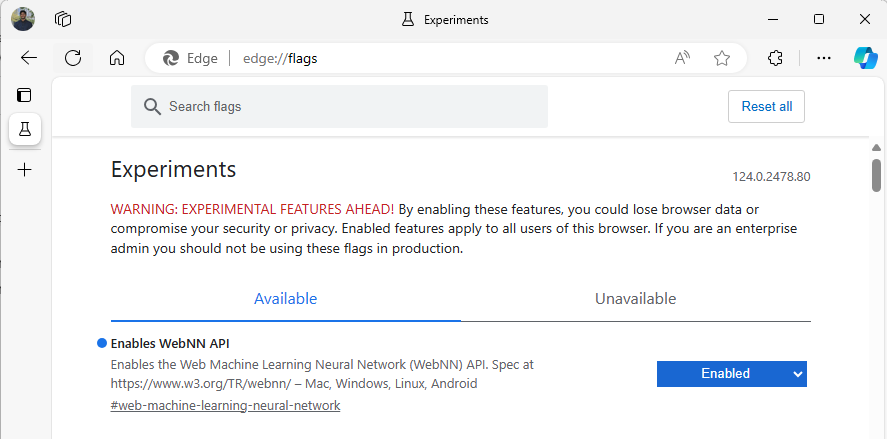WebNN API チュートリアル
オペレーティング システムのサポート、モデルのサポートなど、WebNN の概要については、WebNN の概要をご覧ください。
このチュートリアルでは、WebNN API を使用して、デバイス上の GPU でハードウェア高速化された画像分類システムを Web 上に構築する方法について説明します。 画像の分類に使用される Hugging Face のオープンソース モデルである MobileNetv2 モデルを活用します。
このチュートリアルの最終的なコードを確認して実行する場合は、WebNN Developer Preview GitHub で見つけることができます。
Note
WebNN API は W3C Candidate Recommendation であり、開発者プレビューの初期段階にあります。 機能は一部制限されます。 現在のサポートと実装の状態はリストにまとめています。
要件と設定:
Windows の設定
「WebNN 要件」セクションで詳細に説明されているように、Edge、Windows、およびハードウェア ドライバーが正しいバージョンであることを確認します。
Edge の設定
Microsoft Edge Dev をダウンロードしてインストールします。
Edge Beta を起動し、アドレス バーの
about:flagsに移動します。「WebNN API」を検索し、ドロップダウンをクリックして [Enabled] に設定します。
プロンプトに従って Edge を再起動します。

開発環境の設定
Visual Studio Code (VSCode) をダウンロードしてインストールします。
VSCode を起動します。
VSCode 内で VSCode の拡張機能である Live Server をダウンロードしてインストールします。
File --> Open Folderを選択し、目的の場所に空のフォルダーを作成します。
手順 1: Web アプリを初期化する
- まず、新しい
index.htmlページを作成します。 次の定型コードを次の新しいページに追加します。
<!DOCTYPE html>
<html lang="en">
<head>
<meta charset="UTF-8">
<meta name="viewport" content="width=device-width, initial-scale=1.0">
<title>My Website</title>
</head>
<body>
<main>
<h1>Welcome to My Website</h1>
</main>
</body>
</html>
- VSCode の右下にある [Go Live] ボタンを選択して、定型コードと開発者のセットアップが有効であることを確認します。 これにより、定型コードを実行している Edge Beta でローカル サーバーが起動します。
- ここで、
main.jsという名前の新しいファイルを作成します。 このファイルには、アプリのすべての JavaScript コードが含まれます。 - 次に、ルート ディレクトリの下に
imagesという名前のサブフォルダーを作成します。 フォルダー内の画像をダウンロードして保存します。 このデモでは、image.jpgという既定の名前を使用します。 - ONNX Model Zoo から mobilenet モデルをダウンロードします。 このチュートリアルでは、mobilenet2-10.onnx ファイルを使用します。 このモデルを Web アプリのルート フォルダーに保存します。
- 最後に、
imagenetClasses.jsにあるこのイメージ クラス ファイルをダウンロードして保存します。 これにより、モデルで使用するイメージの 1000 の一般的な分類が提供されます。
手順 2: UI 要素と親関数を追加する
- 前の手順で追加した
<main>html タグの本文内で、既存のコードを次の要素に置き換えます。 これにより、ボタンが作成され、デフォルトの画像が表示されます。
<h1>Image Classification Demo!</h1>
<div><img src="./images/image.jpg"></div>
<button onclick="classifyImage('./images/image.jpg')" type="button">Click Me to Classify Image!</button>
<h1 id="outputText"> This image displayed is ... </h1>
- ここで、ONNX Runtime Web をページに追加してみましょう。これは、WebNN API へのアクセスに使用する JavaScript ライブラリです。
<head>html タグの本文内に、次の JavaScript ソース リンクを追加します。
<script src="./main.js"></script>
<script src="imagenetClasses.js"></script>
<script src="https://cdn.jsdelivr.net/npm/onnxruntime-web@1.18.0-dev.20240311-5479124834/dist/ort.webgpu.min.js"></script>
main.jsファイルを開き、次のコード スニペットを追加します。
async function classifyImage(pathToImage){
var imageTensor = await getImageTensorFromPath(pathToImage); // Convert image to a tensor
var predictions = await runModel(imageTensor); // Run inference on the tensor
console.log(predictions); // Print predictions to console
document.getElementById("outputText").innerHTML += predictions[0].name; // Display prediction in HTML
}
手順 3: データを前処理する
- 先ほど追加した関数により、実装する必要がある別の関数である
getImageTensorFromPathが呼び出されます。 この関数を、画像自体を取得するために呼び出す別の非同期関数と同様に、以下に追加します。
async function getImageTensorFromPath(path, width = 224, height = 224) {
var image = await loadImagefromPath(path, width, height); // 1. load the image
var imageTensor = imageDataToTensor(image); // 2. convert to tensor
return imageTensor; // 3. return the tensor
}
async function loadImagefromPath(path, resizedWidth, resizedHeight) {
var imageData = await Jimp.read(path).then(imageBuffer => { // Use Jimp to load the image and resize it.
return imageBuffer.resize(resizedWidth, resizedHeight);
});
return imageData.bitmap;
}
- また、前の手順で参照された
imageDataToTensor関数も追加する必要があります。これにより、読み込まれた画像が、ONNX モデルで機能するテンソル形式にレンダリングされます。 これはより複雑な関数ですが、類似の画像分類アプリを使用したことがあれば馴染みがあるかもしれません。 詳細な説明については、こちらの ONNX チュートリアルをご覧ください。
function imageDataToTensor(image) {
var imageBufferData = image.data;
let pixelCount = image.width * image.height;
const float32Data = new Float32Array(3 * pixelCount); // Allocate enough space for red/green/blue channels.
// Loop through the image buffer, extracting the (R, G, B) channels, rearranging from
// packed channels to planar channels, and converting to floating point.
for (let i = 0; i < pixelCount; i++) {
float32Data[pixelCount * 0 + i] = imageBufferData[i * 4 + 0] / 255.0; // Red
float32Data[pixelCount * 1 + i] = imageBufferData[i * 4 + 1] / 255.0; // Green
float32Data[pixelCount * 2 + i] = imageBufferData[i * 4 + 2] / 255.0; // Blue
// Skip the unused alpha channel: imageBufferData[i * 4 + 3].
}
let dimensions = [1, 3, image.height, image.width];
const inputTensor = new ort.Tensor("float32", float32Data, dimensions);
return inputTensor;
}
手順 4: WebNN を呼び出す
- これで、画像を取得してテンソルとしてレンダリングするために必要なすべての関数を追加しました。 ここで、前の手順で読み込んだ ONNX Runtime Web ライブラリを使用して、モデルを実行します。 なお、ここで WebNN を使用するには
executionProvider = "webnn"を指定するだけです。ONNX Runtime のサポートにより、WebNN は非常に簡単に有効化できます。
async function runModel(preprocessedData) {
// Set up environment.
ort.env.wasm.numThreads = 1;
ort.env.wasm.simd = true;
ort.env.wasm.proxy = true;
ort.env.logLevel = "verbose";
ort.env.debug = true;
// Configure WebNN.
const executionProvider = "webnn"; // Other options: webgpu
const modelPath = "./mobilenetv2-7.onnx"
const options = {
executionProviders: [{ name: executionProvider, deviceType: "gpu", powerPreference: "default" }],
freeDimensionOverrides: {"batch": 1, "channels": 3, "height": 224, "width": 224}
};
modelSession = await ort.InferenceSession.create(modelPath, options);
// Create feeds with the input name from model export and the preprocessed data.
const feeds = {};
feeds[modelSession.inputNames[0]] = preprocessedData;
// Run the session inference.
const outputData = await modelSession.run(feeds);
// Get output results with the output name from the model export.
const output = outputData[modelSession.outputNames[0]];
// Get the softmax of the output data. The softmax transforms values to be between 0 and 1.
var outputSoftmax = softmax(Array.prototype.slice.call(output.data));
// Get the top 5 results.
var results = imagenetClassesTopK(outputSoftmax, 5);
return results;
}
手順 5: データを後処理する
- 最後に、
softmax関数を追加してから最終的な関数を追加すると、最も可能性の高い画像分類が返されます。 このsoftmaxにより、値が 0 から 1 の間に変換されます。これは、この最終的な分類に必要な確率形式です。
まず、ヘルパー ライブラリ Jimp および Lodash の次のソース ファイルを head タグ main.js に追加します。
<script src="https://cdnjs.cloudflare.com/ajax/libs/jimp/0.22.12/jimp.min.js" integrity="sha512-8xrUum7qKj8xbiUrOzDEJL5uLjpSIMxVevAM5pvBroaxJnxJGFsKaohQPmlzQP8rEoAxrAujWttTnx3AMgGIww==" crossorigin="anonymous" referrerpolicy="no-referrer"></script>
<script src="https://cdn.jsdelivr.net/npm/lodash@4.17.21/lodash.min.js"></script>
続いて、次の関数を main.js に追加します。
// The softmax transforms values to be between 0 and 1.
function softmax(resultArray) {
// Get the largest value in the array.
const largestNumber = Math.max(...resultArray);
// Apply the exponential function to each result item subtracted by the largest number, using reduction to get the
// previous result number and the current number to sum all the exponentials results.
const sumOfExp = resultArray
.map(resultItem => Math.exp(resultItem - largestNumber))
.reduce((prevNumber, currentNumber) => prevNumber + currentNumber);
// Normalize the resultArray by dividing by the sum of all exponentials.
// This normalization ensures that the sum of the components of the output vector is 1.
return resultArray.map((resultValue, index) => {
return Math.exp(resultValue - largestNumber) / sumOfExp
});
}
function imagenetClassesTopK(classProbabilities, k = 5) {
const probs = _.isTypedArray(classProbabilities)
? Array.prototype.slice.call(classProbabilities)
: classProbabilities;
const sorted = _.reverse(
_.sortBy(
probs.map((prob, index) => [prob, index]),
probIndex => probIndex[0]
)
);
const topK = _.take(sorted, k).map(probIndex => {
const iClass = imagenetClasses[probIndex[1]]
return {
id: iClass[0],
index: parseInt(probIndex[1].toString(), 10),
name: iClass[1].replace(/_/g, " "),
probability: probIndex[0]
}
});
return topK;
}
- これで、基本的な Web アプリで WebNN を使用して画像分類を実行する際に必要なすべてのスクリプトを追加しました。 VSCode の拡張機能である Live Server を使用して、基本的な Web ページをアプリ内で起動し、分類の結果を自分で確認できるようになりました。